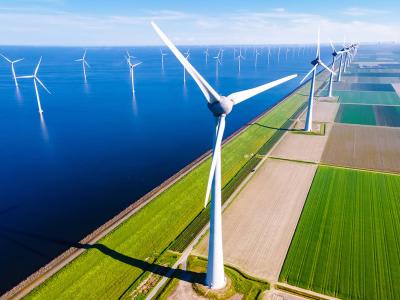Key takeaways
Authors


Please note: All monetary sums marked with ‘$’ are in USD.
COP28 in Dubai served as a focal point in the ongoing global efforts to address climate change. As in previous years, various initiatives and announcements were made; from a landmark deal that saw nearly 200 countries pledging to reduce the global consumption of fossil fuels, signalling the beginning of the end for the oil era to the financial intricacies of sustainable green financing; the operationalisation of the Loss and Damage Fund; and the evolving role of hydropower. This year’s COP28 programme presented a comprehensive overview of the complexities inherent in the pursuit of environmental sustainability.
Amidst the diplomatic exchanges and high-profile pledges, there exists a recognition of the multifaceted nature of the climate crisis and the challenges that accompany the transition toward sustainable practices. Geopolitical intricacies, economic considerations, and the transition away from deeply ingrained fossil fuel reliance add layers of complexity to the international discourse of sustainability. With that being said, here are the key takeaways from COP28 and what the middle market can do to prepare as the world moves towards a greener future.
Renewable energy
Renewable energy has always been one of the most prominent points on the ESG agenda. So, unsurprisingly, one of the most widely supported COP28 summit initiatives has seen well over 100 governments pledging to triple the world's renewable energy capacity by 2030. The initiative was first proposed by the European Commission President in April and sets global targets to triple the installed capacity of renewable energy to at least 11 terawatts. Not only this, the initiative also seeks to double the rate of global energy efficiency improvements from roughly 2% to an annual figure of 4% - potentially providing a route to cut the share of fossil fuels in the world’s energy production. A number of countries have already backed this initiative, such as Brazil, Nigeria, Australia, Japan, Canada, Chile and Barbados – and while China and India have remained silent in backing the overall pledge, they have signalled their support for tripling renewable energy by 2030.
Of course, there was also a slew of other announcements made at COP28, many of which were aimed at decarbonising the energy sector – the source of around three-quarters of global greenhouse gas emissions. The announcements included calls for expanding nuclear power, cutting methane emissions, and limiting private finance for coal power in a bid to phase out fossil fuels.
But where does the middle market stand within this? At present, middle-market businesses see the value in renewable energy adoption, but challenges are slowing down a widespread buy-in. Such challenges include initial costs, limited access to financing, and regulatory uncertainties. A large factor in slow adoption is the simple fact that short-term financial priorities often overshadow the longer payback periods for renewable investments. Overcoming these hurdles requires targeted financial incentives, stable regulatory environments, technological advancements, and comprehensive awareness programs to facilitate a broader understanding of the economic and environmental advantages of transitioning to renewable energy sources. In addition, meeting standardised regulatory requirements and consumer expectations is helping to drive the adoption of renewables.
The value of renewable energy is as immense for the world at large as it is for middle-market businesses, offering a transformative blend of economic, environmental, and strategic advantages. Beyond cost savings through reduced reliance on conventional energy sources, it enhances brand reputation by aligning with global sustainability goals. This commitment attracts conscious consumers and leads to a competitive advantage in return. Renewable energy adoption, for example, may offer security to businesses against increasing costs and be more financially appealing as regulatory entities push to incentivise energy transitions. It positions middle-market businesses at the forefront of their industries, contributing to long-term stability, community engagement, and a lower environmental footprint.
Because many publicised benefits of renewable energy adoption have a long-term focus on value creation, the short-term advantages often go unnoticed. Immediate cost savings can result from reduced energy bills and available tax incentives. Enhanced brand reputation can also attract customers, increasing short-term revenues. Energy independence and resilience provide short-term and long-term stability and are crucial for business continuity. Moreover, regulatory compliance offers immediate legal security. In the short term, middle-market businesses can gain a competitive edge while navigating uncertainty in the market. The integration of renewable energy, for example, delivers both immediate and long-term advantages, making it a strategic business decision.
Sustainable and green financing
COP28 saw the UAE pledging $270 billion in green finance by 2030 through the nation’s banks, with several development banks making fresh moves to scale up their funding efforts. This has added to other positive announcements made by the UK, France, the World Bank, and other development banks through their decision to pause debt when countries are impacted by natural disasters. This has been well received as it ties in nicely with the loss and damage fund’s central premise, which we will get into later. Other promising developments included:
- Multilateral Development Banks (MDBs) uniting to announce commitments they said will unlock $180 billion in climate finance whilst also unveiling plans to develop a common approach for reporting climate results.
- The Inter-American Development Bank (IDB) announced that it will triple its climate lending to $150 billion over the next decade, while the World Bank committed to increase its climate finance target to 45% by 2025, unlocking an additional $9 billion a year.
- The IDB also announced $5 billion in additional financing for sustainable development projects in the Amazon and a $1 billion equivalent of incentives for countries to meet climate and nature targets through discounts on loans if targets are met.
- The US promised $3 billion to the Green Climate Fund (GCF) for reducing emissions and adapting to climate change in developing countries. With separate pledges from Italy, Switzerland, Portugal and Estonia, the total raised in the latest GCF replenishment round has risen to $12.7 billion.
These investments in green and sustainable finance for developed and emerging markets will drive regulatory reforms and public-private partnerships that include climate-centric investments. Consequently, they have the potential to ignite innovation in technological adoption, green products and services, circular economy initiatives and increasingly positively impact investments in emerging markets. Transforming the frameworks in which the private sector assesses risks and opportunities to incorporate ESG standards will pave the way for businesses to adopt criteria related to environmental sustainability. For example, integrating green banking standards and providing capacity-building grants will incentivise businesses in emerging markets to further explore the financial impact of non-financial risks and opportunities in emerging markets.
By providing these joint ventures and initiatives, there are more opportunities for resource-sharing and training. More attention will consequently be placed on, thus strengthening, domestic capacity-building programmes and green banking practices. MDBs can enable a closer collaboration with national regulatory bodies on development and implementation. Improving on existing monitoring and reporting systems to incorporate green banking measures is equally impactful to inform future capacity-building initiatives and to help assess progress and efficacy. The Reserve Bank of India’s Green Banking Report is a strong reference point in this regard. Additionally, offering concessional loans, guarantees, and risk-sharing mechanisms that increase the focus on ESG-centric investments within financial systems, such as the Climate Investment Funds, provide cost-effective financing for climate action projects and, in return, will place more attention on the green transition.
Loss and Damage Fund
The Loss and Damage (L&D) Fund is an agreement that sees wealthy states and major polluters place millions of dollars towards a fund that will distribute funds to poor states harmed by climate change. The fund has had a contentious history. Initially suggested in 1991 by Vanuatu, a small island nation threatened by rising sea levels caused by global temperature increases, the L&D fund has long been an important point for countries with smaller economies that are worst affected by climate change. The fund was agreed upon in COP27, held in Egypt in 2022, where there were significant disagreements over how the fund would work, who would commit, and who would be eligible to receive the relief.
At COP28, the summit’s President, Dr Sultan Al Jaber, operationalised the fund, making the announcement a big breakthrough. This development provides significant relief to the UAE, the summit’s host. The country was under pressure even before talks began about its fossil fuel expansion plans and the fact that the president of the climate talks is the chief executive of a national oil company. Initial commitments to the fund include:
- The UAE ($100m)
- United Kingdom ($75m)
- United States ($24.5m)
- Japan ($10m)
- Germany ($100m)
The pressure is now building on other wealthy countries to outline their own commitments to the fund, as the sum that is needed for developing countries to benefit from the fund continues to rise; according to The Unitarian Universalist Service Committee (UUSC), a non-profit organisation, the “loss and damage in developing countries is already greater than 400 billion USD per year and expected to grow”.
If done correctly, the L&D fund has the potential to make significant positive impacts. It is projected to enable investments in climate-resilient infrastructure and responsive measures, such as direct financial assistance after climate disasters, and to provide immediate financial relief to impacted businesses while minimising disruptions. Providing climate resilience insurance, financial security, and disaster recovery for businesses in emerging markets and impacted communities will drastically reduce businesses’ vulnerability. Agricultural businesses in poorer states, for example, will rely on the fund to facilitate access to sustainable practices such as agroforestry and drought-resistant seeds. With that said, facilitating access to innovative technologies, sustainable practices, and access to knowledge will be integral to building resilient businesses and protecting them.
Yet, as said before, we are now waiting to see who will step up to the plate and commit to the fund. While it aims to mitigate climate vulnerabilities and address negative impacts, it places a financial burden on wealthier economies expected to contribute to the fund. Businesses are increasingly recognising their moral responsibility to address climate change. However, economic interests and profitability remain at the core of their business models. As a result, this creates tension between prioritising profitability and economic interests and supporting L&D priorities. These tensions can potentially be addressed through innovative approaches such as investing in climate-resilient technologies and solutions, which would create more business opportunities whilst contributing to capacity-building and business resilience.
Hydropower
As part of the transition to renewables, hydropower presents significant potential in supporting the transition of developing economies away from fossil fuels. At COP28, Masdar, a UAE state-owned renewable energy company, and EDF agreed with the Kyrgyz Republic to investigate the potential development of 3.6 gigawatts (GW) of hydropower and renewable energy projects. The Memorandum of Understanding (MoU) was signed at COP28 in Dubai, involving key representatives from the Kyrgyz Ministry of Energy, Masdar and EDF. A Ugandan delegation at COP28 set out a particularly impassioned vision of its hydropower potential and how it is driving investment from the UAE. Separately, the African Development Bank is drawing up plans for $1 billion of upgrades to a dozen hydropower plants in Africa, boosting capacity that is often unable to meet the continent's surging power needs. Ranging from Nigeria's largest 760-megawatt (MW) Kainji plant to South Africa's 2.7 MW Sol Plaatje, the refurbishments are expected to yield an extra 570 MW across the 12 projects. Work on the first plants is likely to start by June 2024.
Hydropower is a reliable renewable energy source that addresses the constant challenge of power inconsistency by offering a stable base load. By curbing dependence on fossil fuels, hydropower mitigates economic vulnerabilities associated with fuel price volatility and supply chain disruptions, fostering energy security. Its environmentally friendly nature reduces air pollution, contributing to improved public health. Beyond energy benefits, hydropower projects stimulate economic growth through infrastructure development and job creation, while technological advancements and responsible planning address ecological and social concerns, ensuring a sustainable transition pathway.
Undoubtedly, the African Development Bank's $1 billion investment to upgrade a dozen hydropower plants in Africa will be transformative. This funding could modernise equipment, enhance efficiency, and increase power generation by 30%. Beyond immediate energy gains, this initiative aligns with Africa's broader sustainable development and transition goals, job creation, and economic growth. Hydropower's reliability and environmental impacts are integral to the continent's transition from fossil fuels. The investment signals a commitment to a cleaner, more resilient energy future, addressing current and long-term sustainability challenges. Such implementation will depend on transparent and accountable governance to ensure equitable distribution.
Regarding middle-market businesses, hydropower's reliability, scalability, and environmental benefits make it an integral part of transitioning away from fossil fuels – where it is possible, of course. Hydropower's capacity for large-scale generation supports the energy demands of growing businesses. Importantly, its low-carbon footprint also aligns with corporate sustainability goals, appealing to environmentally conscious consumers and interested investors. The hydropower infrastructure’s ability to adapt to different scales ensures it is applicable for businesses of various sizes. Its role extends beyond energy; it facilitates resilience, cost-effectiveness, and corporate responsibility, making hydropower a cornerstone in the strategic shift toward sustainable and clean energy practices.
Key takeaways for the middle market
Middle-market businesses gained significant insights from COP28, emphasising collaborative efforts with governments and multilateral development banks. Post-conference, companies exhibited heightened commitments, exemplified by impactful statistics like renewables constituting 28% of new global energy capacity, with an impressive 40% share according to UN statistics. The COP28 outcomes underscored the growing importance of sustainable finance, climate risk, and the urgency in addressing loss and damage. Another important milestone was the Global Stocktake and Fossil Fuels (GST) addressing CO2 and non-CO2, such as methane, emissions. These takeaways highlight the imperative for middle-market enterprises to engage in strategic partnerships, adopt renewable energy solutions, and integrate sustainable finance practices, aligning with global environmental goals and demonstrating a commitment to responsible business practices.
Post-COP28, middle-market businesses face both challenges and opportunities. To meet evolving environmental standards and best practices, organisations must urgently address challenges like capacity building and enhancing operational resilience, while adapting to national and international regulations. However, the commitment to renewables and green and sustainable finance presents an opportunity for businesses to invest in sustainable technologies, which offer avenues for innovation and responsible best practices for businesses. By focusing on proactive solutions to challenges and leveraging emerging opportunities, middle-market businesses can overcome challenges and position themselves as leaders in the sustainable business landscape.
RSM plays a critical role in assisting business leaders in navigating and shaping their organisations' ESG journeys through a comprehensive suite of services. From crafting sustainability strategies and ESG policy frameworks to facilitating ESG reporting, compliance, and regulation adherence, RSM ensures businesses are well-equipped to develop robust strategies, enhance operations, and meet regulatory requirements. As a global organisation, RSM’s specialists can provide expertise in ESG assessments, strategy, risk management and implementation; conduct training and capacity-building initiatives; provide guidance on international frameworks and ESG raters. Adhering to international best practices, RSM empowers business leaders to make informed decisions, fostering sustainable practices that align with global expectations – creating lasting value and confidence through sustainability.
For more information, visit our ESG and sustainability services page.




